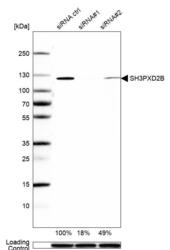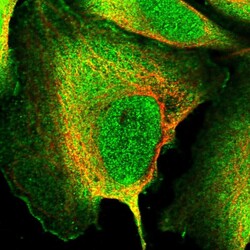Antibody data
- Antibody Data
- Antigen structure
- References [5]
- Comments [0]
- Validations
- Western blot [1]
- Immunocytochemistry [1]
Submit
Validation data
Reference
Comment
Report error
- Product number
- HPA036471 - Provider product page

- Provider
- Atlas Antibodies
- Proper citation
- Atlas Antibodies Cat#HPA036471, RRID:AB_10670799
- Product name
- Anti-SH3PXD2B
- Antibody type
- Polyclonal
- Description
- Polyclonal Antibody against Human SH3PXD2B, Gene description: SH3 and PX domains 2B, Alternative Gene Names: FLJ20831, KIAA1295, Validated applications: WB, IHC, ICC, Uniprot ID: A1X283, Storage: Store at +4°C for short term storage. Long time storage is recommended at -20°C.
- Reactivity
- Human
- Host
- Rabbit
- Conjugate
- Unconjugated
- Isotype
- IgG
- Vial size
- 100 µl
- Concentration
- 0.1 mg/ml
- Storage
- Store at +4°C for short term storage. Long time storage is recommended at -20°C.
- Handling
- The antibody solution should be gently mixed before use.
Submitted references Intercellular transfer of cancer cell invasiveness via endosome-mediated protease shedding
Studying the Association of TKS4 and CD2AP Scaffold Proteins and Their Implications in the Partial Epithelial–Mesenchymal Transition (EMT) Process
A Novel Cell-Based Model for a Rare Disease: The Tks4-KO Human Embryonic Stem Cell Line as a Frank-Ter Haar Syndrome Model System
Complete callosal agenesis, pontocerebellar hypoplasia, and axonal neuropathy due to AMPD2 loss
Mutations in SH3PXD2B cause Borrone dermato-cardio-skeletal syndrome
Wenzel E, Pedersen N, Elfmark L, Wang L, Kjos I, Stang E, Malerød L, Brech A, Stenmark H, Raiborg C
Nature Communications 2024;15(1)
Nature Communications 2024;15(1)
Studying the Association of TKS4 and CD2AP Scaffold Proteins and Their Implications in the Partial Epithelial–Mesenchymal Transition (EMT) Process
Kurilla A, László L, Takács T, Tilajka Á, Lukács L, Novák J, Pancsa R, Buday L, Vas V
International Journal of Molecular Sciences 2023;24(20):15136
International Journal of Molecular Sciences 2023;24(20):15136
A Novel Cell-Based Model for a Rare Disease: The Tks4-KO Human Embryonic Stem Cell Line as a Frank-Ter Haar Syndrome Model System
László L, Maczelka H, Takács T, Kurilla A, Tilajka Á, Buday L, Vas V, Apáti Á
International Journal of Molecular Sciences 2022;23(15):8803
International Journal of Molecular Sciences 2022;23(15):8803
Complete callosal agenesis, pontocerebellar hypoplasia, and axonal neuropathy due to AMPD2 loss
Marsh A, Lukic V, Pope K, Bromhead C, Tankard R, Ryan M, Yiu E, Sim J, Delatycki M, Amor D, McGillivray G, Sherr E, Bahlo M, Leventer R, Lockhart P
Neurology Genetics 2015;1(2)
Neurology Genetics 2015;1(2)
Mutations in SH3PXD2B cause Borrone dermato-cardio-skeletal syndrome
Wilson G, Sunley J, Smith K, Pope K, Bromhead C, Fitzpatrick E, Di Rocco M, van Steensel M, Coman D, Leventer R, Delatycki M, Amor D, Bahlo M, Lockhart P
European Journal of Human Genetics 2013;22(6):741-747
European Journal of Human Genetics 2013;22(6):741-747
No comments: Submit comment
Enhanced validation
- Submitted by
- Atlas Antibodies (provider)
- Enhanced method
- Genetic validation
- Main image

- Experimental details
- Western blot analysis in U2OS cells transfected with control siRNA, target specific siRNA probe #1 and #2, using Anti-SH3PXD2B antibody. Remaining relative intensity is presented. Loading control: Anti-GAPDH.
- Sample type
- Human
- Protocol
- Protocol
Supportive validation
- Submitted by
- Atlas Antibodies (provider)
- Main image

- Experimental details
- Immunofluorescent staining of human cell line U-2 OS shows localization to nucleus & plasma membrane.
- Sample type
- Human
 Explore
Explore Validate
Validate Learn
Learn Western blot
Western blot Immunocytochemistry
Immunocytochemistry Immunohistochemistry
Immunohistochemistry